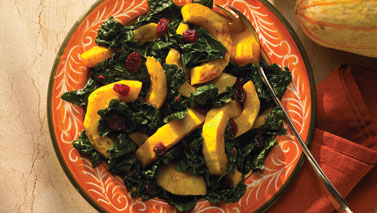Vitality is not a word that arises very often in our daily lives. We know when we feel tired, run-down, exhausted, overwhelmed, depressed or sick — but vital? It calls to mind the phrase ”vital signs,” a topic normally associated with those in dangerously poor health. Rebecca Katz wishes the term got more play in the world of healthy people — and that we were all so attuned to what makes us feel vital that we would demand it from the foods we eat.
Katz is a cancer survivor and the coauthor of the colorful bestseller One Bite at a Time: Nourishing Recipes for Cancer Survivors and Their Friends. She wrote the book for people dealing with cancer, be they caregivers or patients. But it’s not just for sick people; it’s for those who want foods that taste great and give the body all the things it needs to feel at its vital best.
I caught up with Katz by phone recently at a farmers’ market in northern California. “The problem is that there is just so much information out there today about nutrition, superfoods, phytochemicals, antioxidants, good fats, bad fats, and so on, that people lose the thread about why we eat food to begin with,” Katz told me. “I call it nutritional analysis leading to culinary paralysis. People have all this information, and then they have the old foods they’re emotionally connected to,” like casseroles made from processed food, “and they think healthy foods have to be hippie gruel, and then they just freeze. But healthy food is not yucky food!”
To remedy this confusion, Katz focused her book around one guiding principle: We naturally respond to nourishing foods because they taste great. “I know that we gravitate toward foods with the freshest taste, the best taste,” Katz said. “It’s a basic human instinct, to eat well. It’s in our DNA, and no amount of fast food can take that away from us. Maybe we get numb to it over time, but when we’re exposed to nutrient-rich foods with all the good things in them — minerals, antioxidants, phytochemicals — we’re just: Wow! More of that. Give me more of that. That’s why, in my book, I chose to lead with taste. In order for food to be healthy and vital, it needs to be eaten. We don’t get any health benefits from vegetables in the crisper drawer going bad while we order a pizza! Food is only healthy if we eat it, which is why it has to be delicious, it has to be yum!”
For instance, Katz heard from lots of people last year who served her recipe for Delicata Squash With Dino Kale and Cranberries at their family’s Thanksgiving (reprinted below). “I’d hear things like, ‘I told people what I’m bringing, and they responded — You’re not bringing the green bean casserole? You’re not coming!’” Katz recalled. “You know how emotional food is. But then, when the squash and dino kale were actually on the buffet table, people ate it. They loved it! The ‘yums’ were really happening. Kids especially loved it. The thing about that dish that works is, one, it’s beautiful to look at. It’s also got the combinations of flavor in there, a little bit of sweet, a little bit astringent — the taste buds are tickled by that. And then, once people are eating nourishing, whole foods, you just see light bulbs go on over their heads — they feel better, they feel energy, they feel excited, they feel healthy. I’ve seen it time and time again — you pull people in through their taste buds, and their body just responds.”
Cancer patients are acutely attuned to that response, especially when they’re dealing with treatments that leave them feeling thoroughly tapped out. In that situation, Katz says, a bowl of soup made from whole foods can mean the difference between feeling exhausted or energized. What people who don’t have cancer often fail to realize, however, is that you don’t have to be sick before you pay attention to your body’s vitality: The same things that maximize your defenses and resiliency when you’re dealing with cancer are the same things that make you feel nourished and strong when you’re perfectly healthy.
Wouldn’t it be amazing if we all checked in with our own “vital signs” at every meal? If we did, we might eat very differently — satisfying our hunger, and replenishing the source of our vitality in the process.
Delicata Squash With Dino Kale and Cranberries

Serves four
- 6 cups dino kale, stemmed and torn into small, bite-size pieces
- 4 delicata squash
- 2 tbs. extra-virgin olive oil
- 1/4 tsp. dried sage
- 1/4 tsp. ground allspice
- 1/2 tsp. sea salt
- 1/8 tsp. red pepper flakes
- 1/4 cup dried cranberries
Directions
- Preheat the oven to 425 degrees F. Cover the kale with cold water and set aside until ready to use.
- Peel the squash with a sharp vegetable peeler. Cut in half lengthwise, scoop out the core and seeds, and cut into 1/2-inch pieces. Toss the squash with 1 tablespoon of the olive oil, the sage, allspice and 1/4 teaspoon salt. Spread the squash in a single layer on a baking sheet. Roast for 15 minutes, or until tender.
- While the squash is roasting, heat a large sauté pan over medium heat. Add the remaining 1 tablespoon olive oil, red pepper flakes and cranberries. Stir 10 seconds, and add the kale and 1/4 teaspoon salt. Sauté until tender. The water that adheres to the greens should be enough water to cook them. If needed, add 1 tablespoon of water to finish cooking.
- Stir the roasted squash into the sautéed kale. Serve immediately in a shallow serving bowl or as a side dish to a main course.
String Beans with Cherry Tomatoes and Feta Cheese
Serves six
- 1 lb. string beans, “tails” removed
- 1 tsp. sea salt
- 2 tbs. extra-virgin olive oil
- 2 shallots, diced
- 2 garlic cloves, chopped
- 1/2 tsp. dried oregano
- 1/4 cup quartered cherry tomatoes
- 1/3 cup crumbled organic feta cheese
- 1/4 tsp. chopped fresh basil, for garnish
- 1/4 tsp. chopped fresh mint, for garnish
Directions
- Fill a 4- to 6-quart pot three-quarters full with water and bring to a boil. Add the 1 teaspoon salt. Add the string beans, and blanch for three minutes. (If you’re using baby green beans, blanch one minute.) Drain the string beans and place in an ice water bath. This stops the cooking process and preserves their great color.
- In a sauté pan over medium heat, heat the olive oil. Add the shallots, and sauté for three to five minutes, until the shallots are caramelized. Add the garlic and oregano, and sauté for 30 seconds, just until aromatic.
- Add the blanched beans to the sauté pan with a pinch of salt and a tablespoon of water. Reduce the heat to low and cook until tender. As they cook, taste the beans for doneness.
- Put the cooked beans in a serving bowl or on a platter, and toss with the tomatoes and feta. Garnish with the basil and mint, and serve immediately.
Recipe excerpted from One Bite at a Time: Nourishing Recipes for Cancer Survivors and Their Friends by Rebecca Katz, with Marsha Tomassi and Mat Edelson.
This article originally appeared as “Vital Nourishment.”




This Post Has 0 Comments